Multi-Criteria Decision Making in Production Fields: A Structured Content Analysis and Implications for Practice
Abstract
1. Introduction
2. Materials and Methods
2.1. Sources and Search Protocol
2.2. Selection of Scientific Documents
2.3. Database Preparation and Pre-Processing
3. Results
3.1. Data Analysis
3.2. Analysis of Contributions
- Problem statement: involvement for the definition of the type of problem (choice, ranking or sorting);
- Criteria: involvement in the definition of the criteria structure (flat or hierarchical); measurement scale and performance type.
- Definition of preference: in particular, the involvement in the elicitation of preferences phase;
- Qualitative and technical support: involvement in defining the number of criteria or alternatives, use of software; feedback on the understanding of the method in its use or in its processing time.
3.3. Contributions to Knowledge and Implications for Practice
4. Conclusions
Funding
Conflicts of Interest
Appendix A
| Step I | Step II | Step III | |||||||||||||
|---|---|---|---|---|---|---|---|---|---|---|---|---|---|---|---|
| Application Area | Authors | Methods | a: Problem Statement | b: Alternatives | c: Structure | d: Measurement Scale | e: Performance Type | f: Elicitation of Preferences | f1: If Direct | f2: If Indirect | g: Aggregation | h: Easiness of Use | i: Processing Time | l: No. Alternatives/Criteria | n: Software Support |
| Company Adaptability | Larrodé et al. (2012) | AHP | 2 | 1 | 2 | 1 | 1 | 1 | 1f | 0 | 2 | 1 | 3 | 2 | 3 |
| Errors in Production Process | Fattoruso and Barbati (2021) | ELECTRE TRI NC, AHPSort II | 2 | 1 | 2 | 1 | 1 | 1 | 1f | 0 | 2 | 2 | 2 | 1 | 1 |
| Fattoruso et al. (2022a) | AHPSort II, Portfolio Decision Analysis | 2 | 1 | 2 | 1 | 1 | 1 | 1l | 0 | 2 | 2 | 2 | 1 | 3 | |
| Ammirato et al. (2022) Fattoruso et al. (2022b) | Parsimonious AHP, DEA | 1 | 1 | 2 | 1 | 1 | 1 | 1f | 0 | 2 | 2 | 2 | 2 | 1 | |
| Human Reliability | Petruni et al. (2019) | AHP | 1 | 1 | 2 | 1 | 1 | 1 | 1f | 0 | 2 | 1 | 3 | 2 | 1 |
| Material Selection | Moradian et al. (2019) | AHP, MOORA, TOPSIS and VIKOR | 1 | 1 | 2 | 3 | 1 | 1 | 1f | 0 | 2 | 1 | 3 | 3 | 2 |
| Jahan et al. (2022) | WSM, WPM, TOPSIS, | 1 | 1 | 2 | 1 | 1 | 1 | 1f | 0 | 2 | 1 | 2 | 3 | 2 | |
| Wang and Li (2022) | fuzzy AHP | 1 | 1 | 2 | 1 | 1 | 1 | 1f | 0 | 2 | 1 | 1 | 3 | 2 | |
| Ali et al. (2015) | AHP | 1 | 1 | 2 | 1 | 1 | 1 | 1f | 0 | 2 | 1 | 3 | 1 | 3 | |
| Performance Evaluation | Sirikrai and Tang (2006) | AHP | 1 | 1 | 2 | 1 | 1 | 1 | 1f | 0 | 2 | 1 | 3 | 3 | 2 |
| Gothwal and Raj (2018) | AHP | 1 | 1 | 2 | 2 | 1 | 1 | 1f | 0 | 2 | 1 | 3 | 2 | 2 | |
| Alhuraish et al. (2016) | AHP, SIX SIGMA | 1 | 1 | 2 | 3 | 1 | 1 | 1f | 0 | 2 | 1 | 3 | 3 | 3 | |
| Chahid et al. (2014) | AHP | 1 | 1 | 2 | 3 | 1 | 1 | 1f | 0 | 2 | 1 | 3 | 3 | 2 | |
| Cristea and Cristea (2021) | AHP | 1 | 1 | 2 | 3 | 1 | 1 | 1f | 0 | 2 | 1 | 3 | 2 | 3 | |
| Parthiban and Zubar (2013) | AHP | 1 | 1 | 1 | 3 | 1 | 1 | 1f | 0 | 2 | 1 | 1 | 3 | 2 | |
| Production Planning and Control | Muerza et al. (2014) | AHP | 1 | 1 | 2 | 3 | 1 | 1 | 1f | 0 | 2 | 1 | 1 | 2 | 3 |
| Küçükoğlu et al. (2017) | FAHP, FTOPSIS, FVIKOR, GOAL PROGRAMMING | 1 | 1 | 2 | 3 | 1 | 1 | 1f | 0 | 2 | 1 | 3 | 3 | 2 | |
| Project Selection | Vinodh and Swarnakar (2015) | Fuzzy ANP, DEMATEL, TOPSIS | 1 | 1 | 2 | 3 | 1 | 1 | 1f | 0 | 2 | 2 | 2 | 2 | 2 |
| Quality Problems | Putri and Irianto (2014) | AHP | 1 | 1 | 1 | 3 | 1 | 1 | 1f | 0 | 2 | 1 | 1 | 3 | 2 |
| Zhou et al. (2018) | VIKOR | 1 | 1 | 2 | 3 | 1 | 1 | 1c | 0 | 1 | 2 | 2 | 2 | 2 | |
| Baidya et al. (2018) | AHP | 1 | 1 | 2 | 3 | 1 | 1 | 1f | 0 | 2 | 1 | 3 | 2 | 2 | |
| Remanufacturing | Abdulrahman et al. (2015) | AHP | 1 | 1 | 1 | 3 | 1 | 1 | 1f | 0 | 2 | 1 | 1 | 3 | 2 |
| Subramoniam et al. (2013) | AHP | 1 | 1 | 1 | 3 | 1 | 1 | 1f | 0 | 2 | 1 | 3 | 3 | 2 | |
| Tian et al. (2014) | AHP | 1 | 1 | 2 | 3 | 1 | 1 | 1f | 0 | 2 | 1 | 3 | 2 | 2 | |
| Yang et al. (2017) | Fuzzy TOPSIS | 1 | 1 | 1 | 3 | 1 | 1 | 1c | 0 | 1 | 2 | 2 | 2 | 2 | |
| Resource Planning | Kahraman et al. (2010) | FAHP | 1 | 1 | 2 | 3 | 1 | 1 | 1f | 0 | 2 | 2 | 2 | 2 | 2 |
| Risk Evaluation | Kull and Talluri (2008) | AHP | 1 | 1 | 2 | 1 | 1 | 1 | 1f | 0 | 2 | 3 | 3 | 3 | 2 |
| Topcu et al. (2018) | AHP | 1 | 1 | 2 | 1 | 1 | 1 | 1f | 0 | 2 | 3 | 3 | 3 | 2 | |
| Unver et al. (2020) | ANP | 2 | 1 | 2 | 3 | 1 | 1 | 1f | 0 | 2 | 2 | 2 | 1 | 2 | |
| Supplier Selection | Hadian et al. (2020) | VIKOR-AHP | 1 | 1 | 2 | 1 | 1 | 1 | 1c | 0 | 1 | 2 | 2 | 2 | 2 |
| Luthra et al. (2017) | AHP-VIKOR | 1 | 1 | 2 | 2 | 1 | 1 | 1f | 0 | 2 | 1 | 3 | 2 | 2 | |
| Chul Park and Lee (2018) | AHP-DEA | 1 | 1 | 1 | 3 | 1 | 1 | 1f | 0 | 2 | 1 | 1 | 3 | 2 | |
| Suraraksa and Shin (2019) | AHP | 1 | 1 | 2 | 3 | 1 | 1 | 1f | 0 | 2 | 1 | 3 | 2 | 2 | |
| Dang et al. (2022) | fuzzy AHP | 1 | 1 | 2 | 3 | 1 | 1 | 1f | 0 | 1 | 2 | 2 | 2 | 2 | |
| Sahu et al. (2022) | AHP, DEMATEL, ANP, MOORA, SAW | 1 | 1 | 2 | 1 | 1 | 1 | 1c | 0 | 1 | 2 | 2 | 1 | 2 | |
| Supply Chain | Junaid et al. (2019) | AHP-TOPSIS | 1 | 1 | 2 | 3 | 1 | 1 | 1f | 0 | 2 | 2 | 2 | 2 | 2 |
| De Felice and Petrillo (2013) | ANP | 1 | 1 | 2 | 3 | 1 | 1 | 1f | 0 | 2 | 2 | 2 | 1 | 2 | |
| Kumar Singh and Modgil (2020) | DEMATEL, fuzzy-VIKOR, | 1 | 1 | 2 | 3 | 1 | 1 | 1f | 0 | 2 | 1 | 2 | 3 | 2 | |
| Sustainability | Salvado et al. (2015) | AHP | 1 | 1 | 2 | 3 | 1 | 1 | 1f | 0 | 2 | 1 | 3 | 3 | 2 |
| Shao et al. (2016) | AHP | 1 | 1 | 2 | 3 | 1 | 1 | 1f | 0 | 2 | 1 | 3 | 3 | 2 | |
| Pagone et al. (2020) | TOPSIS | 1 | 1 | 2 | 3 | 1 | 1 | 1c | 0 | 2 | 1 | 3 | 3 | 3 | |
| Hussain et al. (2017) | AHP | 1 | 1 | 2 | 3 | 1 | 1 | 1f | 0 | 2 | 1 | 3 | 3 | 2 | |
| Stoycheva et al. (2018) | AHP | 1 | 1 | 2 | 3 | 1 | 1 | 1f | 0 | 2 | 1 | 3 | 2 | 2 | |
| Technology Transfer | Halili (2020) | AHP | 1 | 1 | 2 | 3 | 1 | 1 | 1c | 0 | 2 | 2 | 2 | 2 | 3 |
| Transportation Problem | Kabir and Sumi (2015) | FAHP PROMETHEE | 1 | 1 | 2 | 2 | 1 | 1 | 1f | 0 | 2 | 1 | 3 | 3 | 2 |
| Abbreviation | Full Name |
|---|---|
| AHP | Analytic Hierarchy Process |
| AHPSort II | Analytic Hierarchy Process Sorting II |
| ANP | Analytic Network Process |
| DEA | Data Envelopment Analysis |
| DEMATEL | DEcision MAking Trial and Evaluation Laboratory |
| ELECTRE TRI NC | Elimination Et Choix Traduisant la Realité TRI NC |
| Fuzzy AHP (or FAHP) | fuzzy Analytic Hierarchy Process |
| Fuzzy ANP (or FANP) | Fuzzy Analytic network Process |
| FTOPSIS | Fuzzy Technique for Order Preference by Similarity to Ideal Solution |
| FVIKOR | Fuzzy VIseKriterijumska Optimizacija I Kompromisno Resenje |
| MOORA | Multi-Objective Optimization by Ratio Analysis |
| Parsimonious AHP (or PAHP) | Parsimonious Analytic Hierarchy Process |
| PDA | Portfolio Decision Analysis |
| PROMETHEE | Preference Ranking Organization Method for Enrichment Evaluation |
| SAW | Simple Additive Weighting |
| TOPSIS | Technique for Order Preference by Similarity to Ideal Solution |
| VIKOR | VIseKriterijumska Optimizacija I Kompromisno Resenje |
| WSM | Weighted Sum Model |
References
- Abdulrahman, Muhammad Dan-Asabe, Nachiappan Subramanian, Chang Liu, and Chengqi Shu. 2015. Viability of remanufacturing practice: A strategic decision making framework for Chinese auto-parts companies. Journal of Cleaner Production 105: 311–23. [Google Scholar] [CrossRef]
- Alcácer, Juan, John Cantwell, and Lucia Piscitello. 2016. Internationalization in the information age: A new era for places, firms, and international business networks? Journal of International Business Studies 47: 499–512. [Google Scholar] [CrossRef]
- Alhuraish, Ibrahim, Christian Robledo, and Abdessamad Kobi. 2016. Assessment of lean manufacturing and six sigma operation with decision making based on the analytic hierarchy process. IFAC-PapersOnLine 49: 59–64. [Google Scholar] [CrossRef]
- Ali, B. A. Ahmed, S. M. Sapuan, E. S. Zainudin, and M. Othman. 2015. Implementation of the expert decision system for environmental assessment in composite materials selection for automotive components. Journal of Cleaner Production 107: 557–67. [Google Scholar]
- Ammirato, Salvatore, Francesco Sofo, Alberto Michele Felicetti, and Cinzia Raso. 2019. A methodology to support the adoption of IoT innovation and its application to the Italian bank branch security context. European Journal of Innovation Management 22: 146. [Google Scholar] [CrossRef]
- Ammirato, Salvatore, Gerarda Fattoruso, and Antonio Violi. 2022. Parsimonious AHP-DEA Integrated Approach for Efficiency Evaluation of Production Processes. Journal of Risk and Financial Management 15: 293. [Google Scholar] [CrossRef]
- Andrade, Antonio Diaz. 2009. Interpretive research aiming at theory building: Adopting and adapting the case study design. The Qualitative Report 14: 42. [Google Scholar] [CrossRef]
- Baidya, Rahul, Prasanta Kumar Dey, Sadhan Kumar Ghosh, and Konstantinos Petridis. 2018. Strategic maintenance technique selection using combined quality function deployment, the analytic hierarchy process and the benefit of doubt approach. The International Journal of Advanced Manufacturing Technology 94: 31–44. [Google Scholar] [CrossRef]
- Barbati, Maria, Salvatore Greco, Milosz Kadziński, and Roman Słowiński. 2018. Optimization of multiple satisfaction levels in portfolio decision analysis. Omega 78: 192–204. [Google Scholar] [CrossRef]
- Basílio, Marcio Pereira, Valdecy Pereira, Helder Gomes Costa, Marcos Santos, and Amartya Ghosh. 2022. A Systematic Review of the Applications of Multi-Criteria Decision Aid Methods (1977–2022). Electronics 11: 1720. [Google Scholar] [CrossRef]
- Bell, R. F., J. B. Dahl, R. A. Moore, and Eija Kalso. 2005. Peri-operative ketamine for acute post-operative pain: A quantitative and qualitative systematic review (Cochrane review). Acta Anaesthesiologica Scandinavica 49: 1405–28. [Google Scholar] [CrossRef]
- Bhamu, Jaiprakash, and Kuldip Singh Sangwan. 2014. Lean manufacturing: Literature review and research issues. International Journal of Operations & Production Management 34: 876–940. [Google Scholar]
- Bisdorff, Raymond, Luis C. Dias, Patrick Meyer, Vincent Mousseau, and Marc Pirlot. 2015. Evaluation and Decision Models with Multiple Criteria. Berlin: Springer. [Google Scholar]
- Branke, Jurgen, Jurgen Branke, Kalyanmoy Deb, Kaisa Miettinen, and Roman Slowiński, eds. 2008. Multiobjective Optimization: Interactive and Evolutionary Approaches. Berlin and Heidelberg: Springer Science & Business Media. [Google Scholar]
- Canonico, Paolo, Ernesto De Nito, Vincenza Esposito, Gerarda Fattoruso, Mario Pezzillo Iacono, and Gianluigi Mangia. 2021. Visualizing knowledge for decision-making in Lean Production Development settings. Insights from the automotive industry. Management Decision 60: 1076–94. [Google Scholar] [CrossRef]
- Cavallo, Bice, Alessio Ishizaka, Maria Grazia Olivieri, and Massimo Squillante. 2019. Comparing inconsistency of pairwise comparison matrices depending on entries. Journal of the Operational Research Society 70: 842–50. [Google Scholar] [CrossRef]
- Cavallo, Bice, and Matteo Brunelli. 2018. A general unified framework for interval pairwise comparison matrices. International Journal of Approximate Reasoning 93: 178–98. [Google Scholar] [CrossRef]
- Chahid, Mohamed Tarek, Jamila El Alami, Aziz Soulhi, and Nouredine El Alami. 2014. Performance measurement model for moroccan automotive suppliers using PMQ and AHP. Modern Applied Science 8: 137. [Google Scholar] [CrossRef]
- Chul Park, Sung, and Jang Hee Lee. 2018. Supplier selection and stepwise benchmarking: A new hybrid model using DEA and AHP based on cluster analysis. Journal of the Operational Research Society 69: 449–66. [Google Scholar] [CrossRef]
- Cinelli, Marco, Milosz Kadziński, Michael Gonzalez, and Roman Słowiński. 2020. How to support the application of multiple criteria decision analysis? Let us start with a comprehensive taxonomy. Omega 96: 102261. [Google Scholar] [CrossRef]
- Cristea, Ciprian, and Maria Cristea. 2021. KPIs for Operational Performance Assessment in Flexible Packaging Industry. Sustainability 13: 3498. [Google Scholar] [CrossRef]
- Dang, Thanh-Tuan, Ngoc-Ai-Thy Nguyen, Van-Thanh-Tien Nguyen, and Le-Thanh-Hieu Dang. 2022. A Two-Stage Multi-Criteria Supplier Selection Model for Sustainable Automotive Supply Chain under Uncertainty. Axioms 11: 228. [Google Scholar] [CrossRef]
- De Felice, Fabio, and Antonella Petrillo. 2013. A strategic multicriteria decision support system to assess the best supply chain distribution strategy and characterize the bullwhip effect. International Journal of Information Systems and Supply Chain Management (IJISSCM) 6: 61–76. [Google Scholar] [CrossRef]
- Dias, Luis C., and Vincent Mousseau. 2018. Eliciting Multi-Criteria Preferences: ELECTRE Models. Elicitation. Cham: Springer, pp. 349–75. [Google Scholar]
- Doumpos, Michalis, Josè Figueira, Salvatore Greco, and Constantin Zopounidis. 2019. New Perspectives in Multiple Criteria Decision Making. Cham: Springer International Publishing. [Google Scholar]
- Fattoruso, Gerarda, and Maria Barbati. 2021. The usefulness of Multi-criteria sorting methods: A case study in the automotive sector. Electronic Journal of Applied Statistical Analysis 14: 277–97. [Google Scholar]
- Fattoruso, Gerarda, Maria Barbati, Alessio Ishizaka, and Massimo Squillante. 2022a. A hybrid AHPSort II and multi-objective portfolio selection method to support quality control in the automotive industry. Journal of the Operational Research Society, 1–16. [Google Scholar] [CrossRef]
- Fattoruso, Gerarda, Salvatore Scognamiglio, and Antonio Violi. 2022b. A New Dynamic and Perspective Parsimonious AHP Model for Improving Industrial Frameworks. Mathematics 10: 3138. [Google Scholar] [CrossRef]
- Ferreira, Aldónio, and David Otley. 2009. The design and use of performance management systems: An extended framework for analysis. Management Accounting Research 20: 263–82. [Google Scholar] [CrossRef]
- Figueira, Josè, Salvatore Greco, and Matthias Ehrgott. 2005. State of the art surveys. In Multiple Criteria Decision Analysis. Berlin and Heidelberg: Springer. [Google Scholar]
- Gothwal, Suman, and Tilak Raj. 2018. Prioritising the performance measures of FMS using multi-criteria decision making approaches. International Journal of Process Management and Benchmarking 8: 59–78. [Google Scholar] [CrossRef]
- Greco, Salvatore, Benedetto Matarazzo, and Roman Slowinski. 2001. Rough sets theory for multicriteria decision analysis. European Journal of Operational Research 129: 1–47. [Google Scholar] [CrossRef]
- Greco, Salvatore, Jose Figueira, and Matthias Ehrgott. 2016. Multiple Criteria Decision Analysis. New York: Springer, vol. 37. [Google Scholar]
- Gubbi, Jayavardhana, Slaven Marusic, Rajkumar Buyya, and Marimuthu Palaniswami. 2013. Internet of Things (IoT): A vision, architectural elements, and future directions. Future Generation Computer Systems 29: 1645–60. [Google Scholar] [CrossRef]
- Guzman, Linett Montano. 2001. Multi-Criteria Decision Making Methods: A Comparative Study. Applied Optimization. Evangelos Triantaphyllou. Amsterdam: Kluwer Academic Publishers, vol. 288, p. 175. [Google Scholar]
- Hadian, Hengameh, S. Chahardoli, Amir-Mohammad Golmohammadi, and Ali Mostafaeipour. 2020. A practical framework for supplier selection decisions with an application to the automotive sector. International Journal of Production Research 58: 2997–3014. [Google Scholar] [CrossRef]
- Halili, Zahra. 2020. Identifying and ranking appropriate strategies for effective technology transfer in the automotive industry: Evidence from Iran. Technology in Society 62: 101264. [Google Scholar] [CrossRef]
- Hussain, Matloub, Amal Alameeri, and Mian M. Ajmal. 2017. Prioritizing sustainable practices of service organizations: An empirical evidence from automobile dealers in UAE. International Journal of Information Systems in the Service Sector (IJISSS) 9: 22–36. [Google Scholar] [CrossRef]
- Hwang, Ching-Lai, and Abu Syed Md Masud. 1979. Methods for multiple objective decision making. In Multiple Objective Decision Making—Methods and Applications. Berlin and Heidelberg: Springer, pp. 21–283. [Google Scholar]
- Hwang, Ching-Lai, and Kwansun Yoon. 1981. Multiple Attribute Decision Making Methods and Applications: A State-of-the-Art Survey. Berlin and Heidelberg: Springer. [Google Scholar]
- Ishizaka, Alessio, and Philippe Nemery. 2013. Multi-Criteria Decision Analysis: Methods and Software. Hoboken: John Wiley & Sons. [Google Scholar]
- Ishizaka, Alessio, and Sajid Siraj. 2018. Are multi-criteria decision-making tools useful? An experimental comparative study of three methods. European Journal of Operational Research 264: 462–71. [Google Scholar] [CrossRef]
- Jacobides, Michael G., John Paul MacDuffie, and C. Jennifer Tae. 2016. Agency, structure, and the dominance of OEMs: Change and stability in the automotive sector. Strategic Management Journal 37: 1942–67. [Google Scholar] [CrossRef]
- Jahan, Farheen, Manoj Soni, Saif Wakeel, Shafi Ahmad, and Sedat Bingol. 2022. Selection of Automotive Brake Material Using Different MCDM Techniques and Their Comparisons. Journal of Engineering Science & Technology Review 15: 24–33. [Google Scholar]
- Johnston, F. R., J. E. Boyland, Maureen Meadows, and E. Shale. 1999. Some properties of a simple moving average when applied to forecasting a time series. Journal of the Operational Research Society 50: 1267–71. [Google Scholar] [CrossRef]
- Junaid, Muhammad, Ye Xue, Muzzammil Wasim Syed, Jizu Li, and Muhammad Ziaullah. 2019. A neutrosophic ahp and topsis framework for supply chain risk assessment in automotive industry of Pakistan. Sustainability 12: 154. [Google Scholar] [CrossRef]
- Kabir, Golam, and Razia Sultana Sumi. 2015. Hazardous waste transportation firm selection using fuzzy analytic hierarchy and PROMETHEE methods. International Journal of Shipping and Transport Logistics 7: 115–36. [Google Scholar] [CrossRef]
- Kahraman, Cengiz, Ahmet Beskese, and Ihsan Kaya. 2010. Selection among ERP outsourcing alternatives using a fuzzy multi-criteria decision making methodology. International Journal of Production Research 48: 547–66. [Google Scholar] [CrossRef]
- Karbassi Yazdi, Amir, Cristi Spulbar, Thomas Hanne, and Ramona Birau. 2022. Ranking performance indicators related to banking by using hybrid multicriteria methods in an uncertain environment: A case study for Iran under COVID-19 conditions. Systems Science & Control Engineering 10: 166–80. [Google Scholar] [CrossRef]
- Küçükoğlu, İlker, Betul Yagmahan, Ahmet Onaylı, Ezgi Didem Çayhan, and Merve Ünal. 2017. Application of goal programming integrated multi-criteria decision making approaches for the stock area selection problem of an automotive company. International Journal of Supply Chain Management 6: 187–98. [Google Scholar]
- Kull, Thomas J., and Srinivas Talluri. 2008. A supply risk reduction model using integrated multicriteria decision making. IEEE Transactions on Engineering Management 55: 409–19. [Google Scholar] [CrossRef]
- Kumar Singh, Rohit, and Sachin Modgil. 2020. Assessment of lean supply chain practices in Indian automotive industry. Global Business Review. [Google Scholar] [CrossRef]
- Larrodé, Emilio, José María Moreno-Jiménez, and M. Victoria Muerza. 2012. An AHP-multicriteria suitability evaluation of technological diversification in the automotive industry. International Journal of Production Research 50: 4889–907. [Google Scholar] [CrossRef]
- Liberati, Alessandro, Douglas G. Altman, Jennifer Tetzlaff, Cynthia Mulrow, Peter C. Gotzsche, John P. A. Ioannidis, Mike Clarke, Philip J. Devereaux, Jos Kleijnen, and David Moher. 2009. The PRISMA statement for reporting systematic reviews and meta-analyses of studies that evaluate health care interventions: Explanation and elaboration. Journal of Clinical Epidemiology 62: e1–e34. [Google Scholar] [CrossRef]
- Luthra, Sunil, Kannan Govindan, Devika Kannan, Sachin Kumar Mangla, and Chandra Prakash Garg. 2017. An integrated framework for sustainable supplier selection and evaluation in supply chains. Journal of Cleaner Production 140: 1686–98. [Google Scholar] [CrossRef]
- Miettinen, Kaisa, Jussi Hakanen, and Dmitry Podkopaev. 2016. Interactive Nonlinear Multiobjective Optimization Methods. In Multiple Criteria Decision Analysis: State of the Art Surveys, 2nd ed. Edited by Salvatore Greco, Matthias Ehrgott and Josè Figueira. Berlin and Heidelberg: Springer, pp. 931–80. [Google Scholar]
- Moher, David, Larissa Shamseer, Mike Clarke, Davina Ghersi, Alessandro Liberati, Mark Petticrew, Paul Shekelle, and Lesley A. Stewart. 2015. Preferred reporting items for systematic review and meta-analysis protocols (PRISMA-P) 2015 statement. Systematic Reviews 4: 1–9. [Google Scholar] [CrossRef]
- Montmain, Jacky, Christophe Labreuche, Abdelhak Imoussaten, and Francois Trousset. 2015. Multi-criteria improvement of complex systems. Information Sciences 291: 61–84. [Google Scholar] [CrossRef][Green Version]
- Moradian, Milad, Vahid Modanloo, and Soroush Aghaiee. 2019. Comparative analysis of multi criteria decision making techniques for material selection of brake booster valve body. Journal of Traffic and Transportation Engineering (English Edition) 6: 526–34. [Google Scholar] [CrossRef]
- Muerza, Victoria, Daniel de Arcocha, Emilio Larrodé, and José Marìa Moreno-Jiménez. 2014. The multicriteria selection of products in technological diversification strategies: An application to the Spanish automotive industry based on AHP. Production Planning & Control 25: 715–28. [Google Scholar]
- Mulliner, Emma, Naglis Malys, and Vida Maliene. 2016. Comparative analysis of MCDM methods for the assessment of sustainable housing affordability. Omega 59: 146–56. [Google Scholar] [CrossRef]
- Opricovic, Serafim, and Gwo-Hshiung Tzeng. 2004. Compromise solution by MCDM methods: A comparative analysis of VIKOR and TOPSIS. European Journal of Operational Research 156: 445–55. [Google Scholar] [CrossRef]
- Pagone, Emanuele, Michail Papanikolaou, Konstantinos Salonitis, and Mark Jolly. 2020. Multi-criteria decision-making for the life cycle of sustainable high pressure die casting products. International Journal of Sustainable Manufacturing 4: 101–20. [Google Scholar] [CrossRef]
- Parthiban, Parthee, and Hameed Abdul Zubar. 2013. An integrated multi-objective decision making process for the performance evaluation of the vendors. International Journal of Production Research 51: 3836–48. [Google Scholar] [CrossRef]
- Partovi, Fariborz Y., and Jonathan Burton. 1993. Using the analytic hierarchy process for ABC analysis. International Journal of Operations & Production Management 13: 29–44. [Google Scholar] [CrossRef]
- Petruni, Alberto, Evanthia Giagloglou, Ewan Douglas, Jie Geng, Maria Chiara Leva, and Micaela Demichela. 2019. Applying Analytic Hierarchy Process (AHP) to choose a human factors technique: Choosing the suitable Human Reliability Analysis technique for the automotive industry. Safety Science 119: 229–39. [Google Scholar] [CrossRef]
- Putri, Nilda Tri, and Dradjad Irianto. 2014. The Delphi hierarchy process-based study of quality engineering in Malaysia and Indonesia automotive companies. The TQM Journal 26: 566–76. [Google Scholar] [CrossRef]
- Roijers, Diederik M., and Shimon Whiteson. 2017. Multi-objective decision making. Synthesis Lectures on Artificial Intelligence and Machine Learning 11: 1–129. [Google Scholar]
- Ruzika, Stefan, and Margaret M. Wiecek. 2005. Approximation methods in multiobjective programming. Journal of Optimization Theory and Applications 126: 473–501. [Google Scholar] [CrossRef]
- Saaty, Thomas L. 1988. What Is the Analytic hiErarchy Process? Mathematical Models for Decision Support. Berlin and Heidelberg: Springer, pp. 109–21. [Google Scholar]
- Sahu, Atul Kumar, Mahak Sharma, Rakesh D. Raut, Anoop Kumar Sahu, Nitin Kumar Sahu, Jiju Antony, and Guilherme Luz Tortorella. 2022. Decision-making framework for supplier selection using an integrated MCDM approach in a lean-agile-resilient-green environment: Evidence from Indian automotive sector. The TQM Journal. ahead-of-print. [Google Scholar] [CrossRef]
- Salvado, Miguel F., Susana G. Azevedo, João CO Matias, and Luís M. Ferreira. 2015. Proposal of a sustainability index for the automotive industry. Sustainability 7: 2113–44. [Google Scholar] [CrossRef]
- Shao, Jing, Marco Taisch, and Miguel Ortega Mier. 2016. A study on a configuration model for facilitating sustainable consumption: A case involving the automobile industry in Italy. Journal of Cleaner Production 137: 507–15. [Google Scholar] [CrossRef]
- Sirikrai, Sajee B., and John C. S. Tang. 2006. Industrial competitiveness analysis: Using the analytic hierarchy process. The Journal of High Technology Management Research 17: 71–83. [Google Scholar] [CrossRef]
- Stoycheva, Stella, Dayton Marchese, Cameron Paul, Sara Padoan, Abdul-salam Juhmani, and Igor Linkov. 2018. Multi-criteria decision analysis framework for sustainable manufacturing in automotive industry. Journal of Cleaner Production 187: 257–72. [Google Scholar] [CrossRef]
- Subramoniam, Ramesh, Donald Huisingh, Ratna Babu Chinnam, and Suresh Subramoniam. 2013. Remanufacturing Decision-Making Framework (RDMF): Research validation using the analytical hierarchical process. Journal of Cleaner Production 40: 212–20. [Google Scholar] [CrossRef]
- Suraraksa, Juthathip, and Kwang Sup Shin. 2019. Comparative analysis of factors for supplier selection and monitoring: The case of the automotive industry in Thailand. Sustainability 11: 981. [Google Scholar] [CrossRef]
- Tian, Guangdong, Jiangwei Chu, Hesuan Hu, and Hongliang Li. 2014. Technology innovation system and its integrated structure for automotive components remanufacturing industry development in China. Journal of Cleaner Production 85: 419–32. [Google Scholar] [CrossRef]
- Toloie-Eshlaghy, Abbas, and Mahdi Homayonfar. 2011. MCDM methodologies and applications: A literature review from 1999 to 2009. Research Journal of International Studies 21: 86–137. [Google Scholar]
- Topcu, Ilker, Berna Unver, Mine Isik, and Ozgur Kabak. 2018. An AHP based prioritization model for risk evaluation factors in the automotive industry. International Journal of the Analytic Hierarchy Process 10. [Google Scholar] [CrossRef]
- Tranfield, David, David Denyer, and Palminder Smart. 2003. Towards a methodology for developing evidence-informed management knowledge by means of systematic review. British Journal of Management 14: 207–22. [Google Scholar] [CrossRef]
- Traub-Merz, Rudolf. 2017. The automotive sector in emerging economies: Industrial policies, market dynamics and trade unions. In Trends & Perspectives in Brazil, China, India, Mexico and Russia. Berlin: Friedrich Ebert Stiftung. [Google Scholar]
- Tzeng, Gwo-Hshiung, and Jih-Jeng Huang. 2011. Multiple Attribute Decision Making: Methods and Applications. Boca Raton: CRC press. [Google Scholar]
- Ülengin, Füsun, Şule Önsel, Emel Aktas, Özgür Kabak, and Özay Özaydın. 2014. A decision support methodology to enhance the competitiveness of the Turkish automotive industry. European Journal of Operational Research 234: 789–801. [Google Scholar] [CrossRef]
- Unver, Berna, Özgür Kabak, Y. Ilker Topcu, Armagan Altinisik, and Ozcan Cavusoglu. 2020. A decision support system for proactive failure prevention: A case in a leading automotive company. Journal of Enterprise Information Management 33: 845–80. [Google Scholar] [CrossRef]
- Van Eck, Nees Jan, and Ludo Waltman. 2007. VOS: A new method for visualizing similarities between objects. In Advances in Data Analysis. Berlin and Heidelberg: Springer, pp. 299–306. [Google Scholar]
- Van Eck, Nees Jan, Ludo Waltman, Rommert Dekker, and Jan Van Den Berg. 2010. A comparison of two techniques for bibliometric mapping: Multidimensional scaling and VOS. Journal of the American Society for Information Science and Technology 61: 2405–16. [Google Scholar] [CrossRef]
- Vinodh, S., and Vikas Swarnakar. 2015. Lean Six Sigma project selection using hybrid approach based on fuzzy DEMATEL–ANP–TOPSIS. International Journal of Lean Six Sigma 6: 313–38. [Google Scholar] [CrossRef]
- Wang, Dengfeng, and Shenhua Li. 2022. Material selection decision-making method for multi-material lightweight automotive body driven by performance. Proceedings of the Institution of Mechanical Engineers, Part L: Journal of Materials: Design and Applications 236: 730–46. [Google Scholar] [CrossRef]
- Womack, James P., and Daniel T. Jones. 1997. Lean thinking—Banish waste and create wealth in your corporation. Journal of the Operational Research Society 48: 1148–48. [Google Scholar] [CrossRef]
- Xu, Te, Dug Hee Moon, and Seung Geun Baek. 2012. A simulation study integrated with analytic hierarchy process (AHP) in an automotive manufacturing system. Simulation 88: 450–63. [Google Scholar] [CrossRef]
- Yahya, Mohd Shahir, Musli Mohammad, Badrul Omar, and Edly Ferdin Ramly. 2016. A review on the selection of lean production tools and techniques. ARPN Journal of Engineering and Applied Sciences 11: 7721–27. [Google Scholar]
- Yamashina, Hajime, K. Stefan, and L. Massone. 2013. World Class Manufacturing. In Methods and Tools for the Fiat Group Automobiles Production System. London: Palgrave Macmillan. [Google Scholar]
- Yang, Shanshan, Nabil Z. Nasr, S. K. Ong, and Andrew Y. C. Nee. 2017. Designing automotive products for remanufacturing from material selection perspective. Journal of Cleaner Production 153: 570–79. [Google Scholar] [CrossRef]
- Zavadskas, Edmundas Kazimieras, and Zenonas Turskis. 2011. Multiple criteria decision making (MCDM) methods in economics: An overview. Technological and Economic Development of Economy 17: 397–427. [Google Scholar] [CrossRef]
- Zhou, Fuli, Xu Wang, and Avinash Samvedi. 2018. Quality improvement pilot program selection based on dynamic hybrid MCDM approach. Industrial Management & Data Systems 118: 144–63. [Google Scholar]

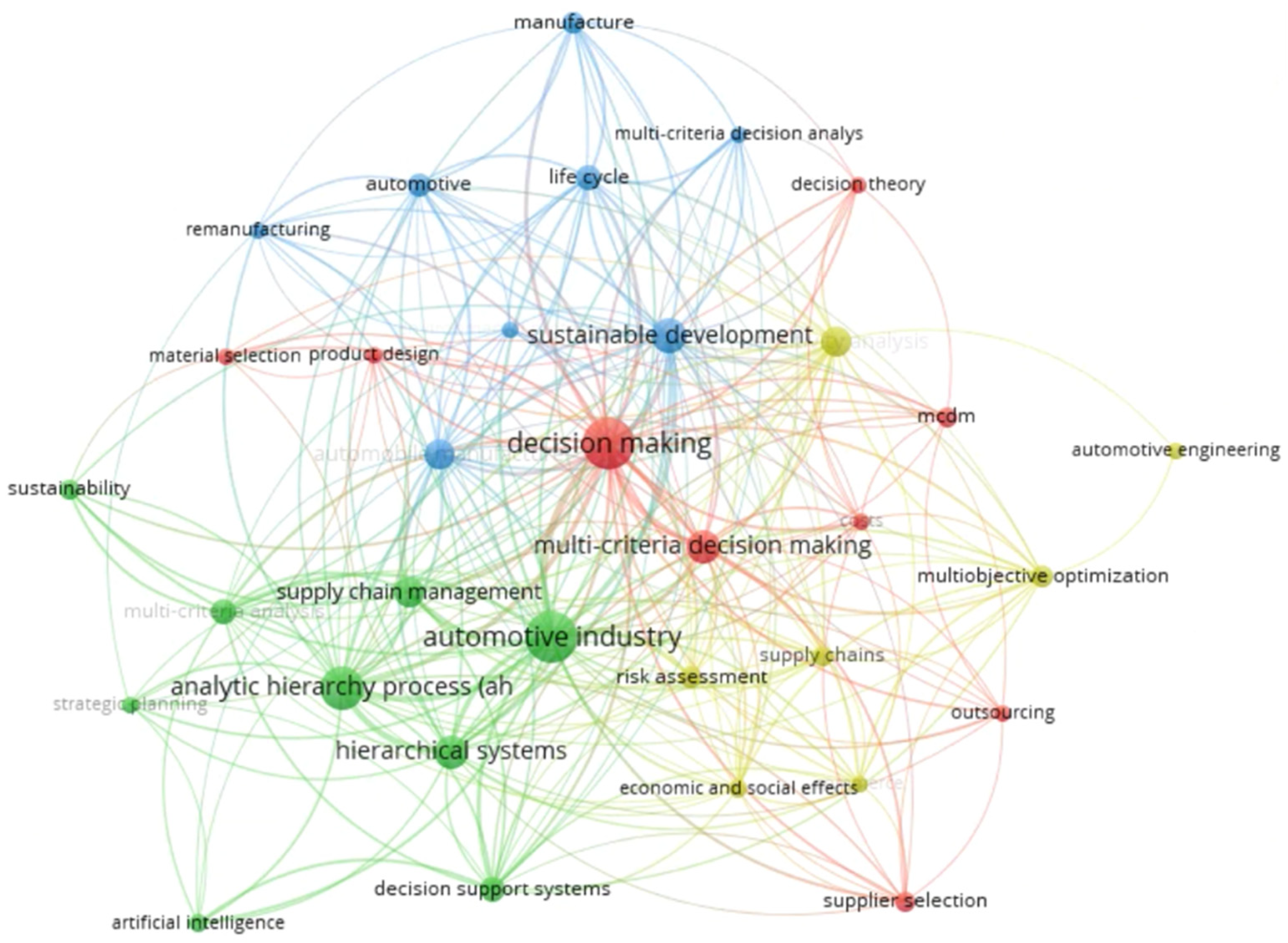
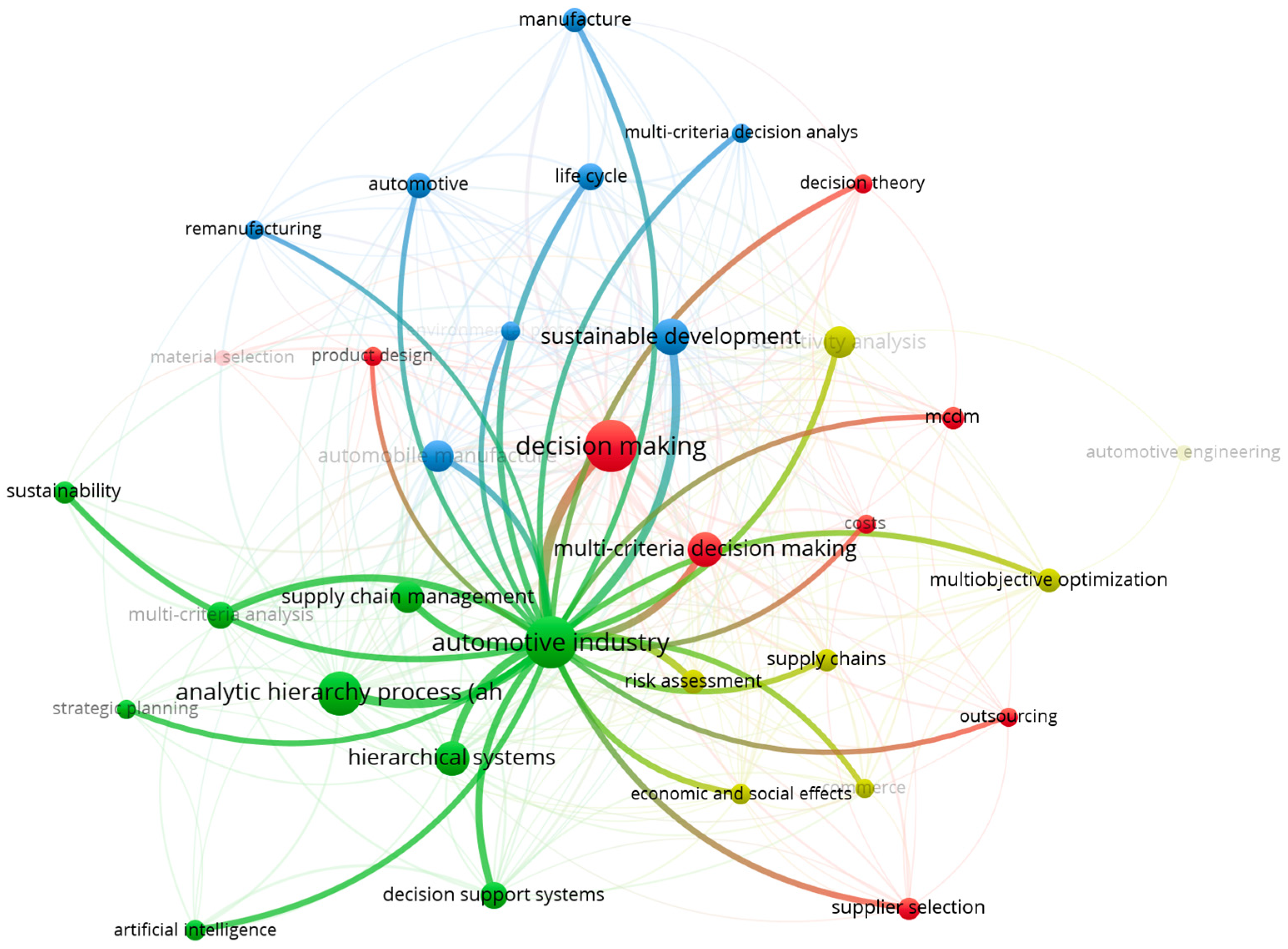
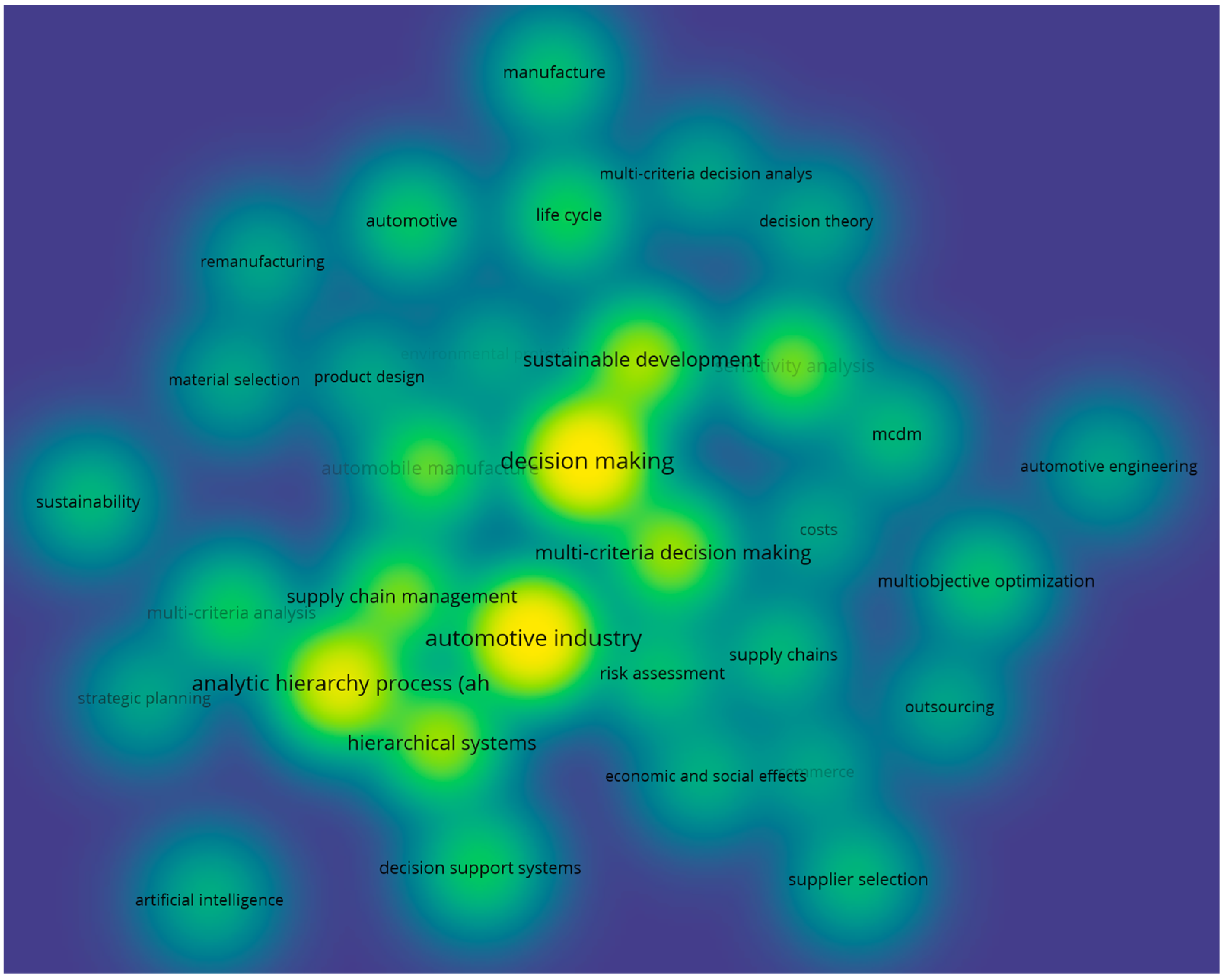
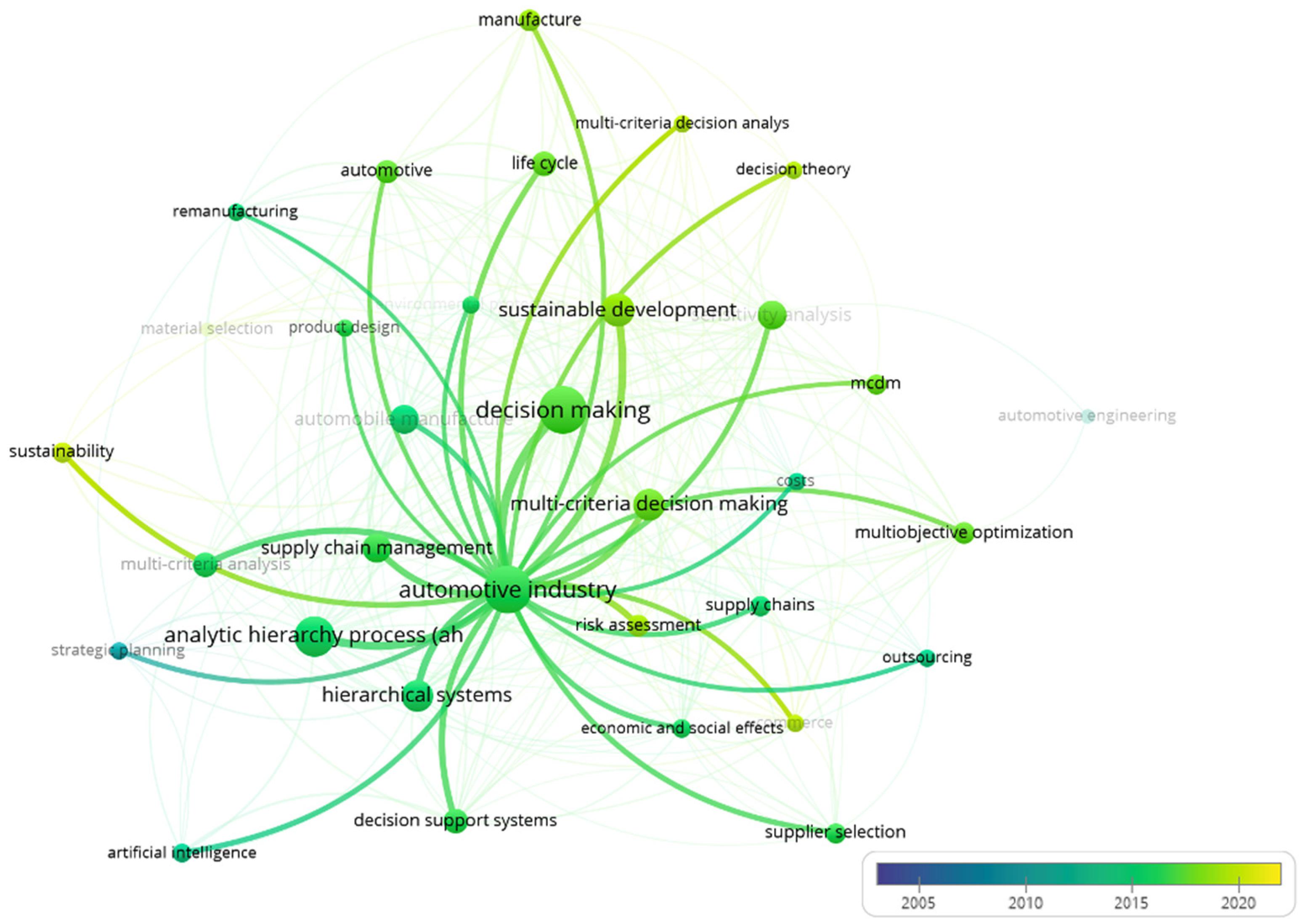

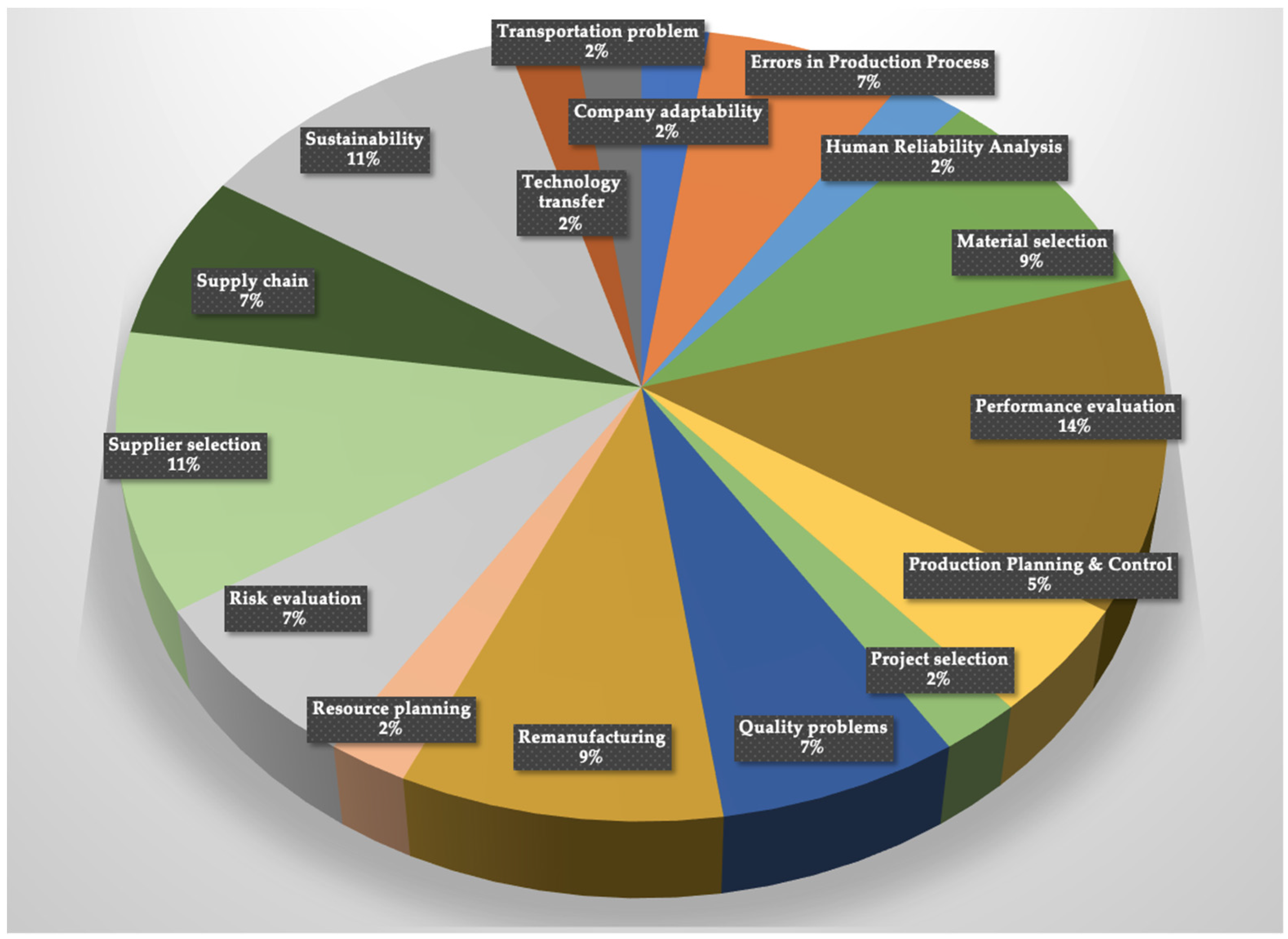
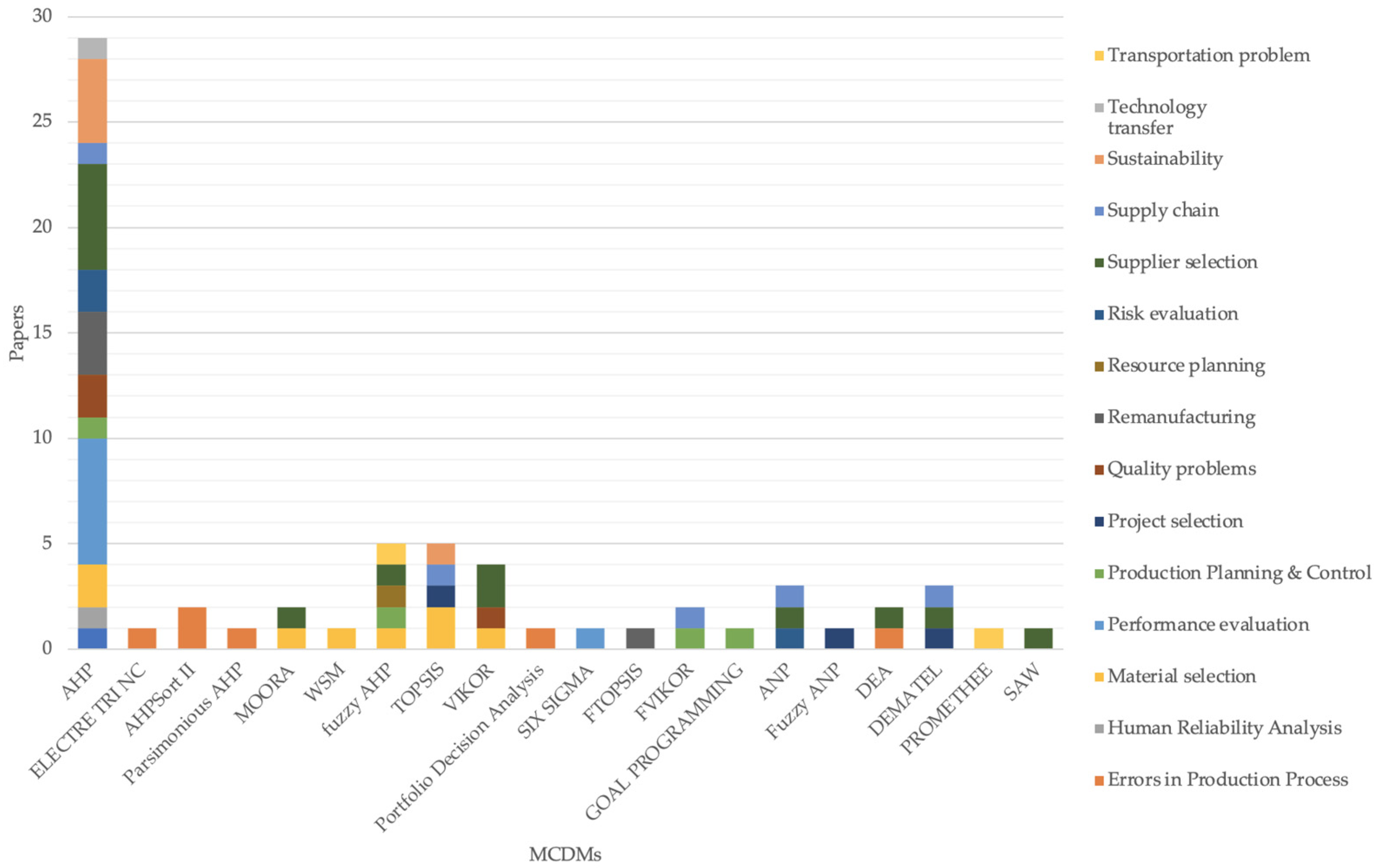
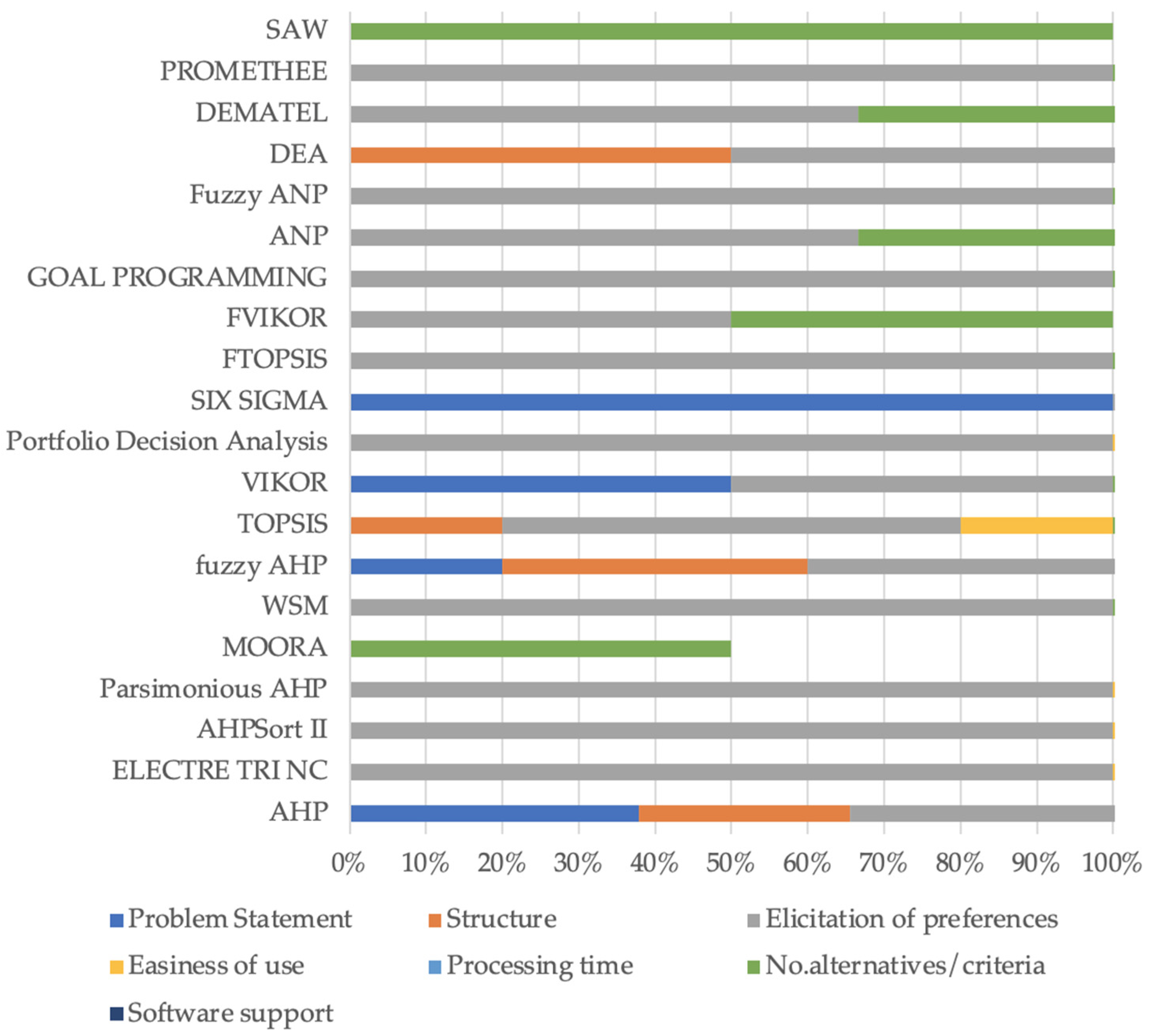
| Density | Cohesion | The literature examined is very cohesive. The cohesion of the scientific landscape is represented by the focus on the keywords “decision making”, “automotive industry”, “analytic hierarchy process” and “sustainable development”. |
| Redundancy | In order to avoid redundancy of information, double or similar keywords have been excluded (e.g., multicriteria/multi-criteria/multi-criteria technique; automobile/automotive; analytic hierarchical process/analytic hierarchy process). | |
| Diameter | Number of Reports/Information decay | The relationships in the literature appear strong and information degradation is minimal. |
| Centralization | Subgroup Peripherals/Structural Center | The academic literature observed is focused on the theme of decision making. Despite this, it is possible to identify growing subgroups linked to the keywords “automotive industry”, “multi-criteria decision making”, “sustainable development” and “decision making” |
| Cluster 1—Red | Cluster 2—Green | Cluster 3—Blue | Cluster 4—Yellow | |
|---|---|---|---|---|
| Keywords | Costs | Analytic Hierarchy Process (AHP) | Automobile manufacturing | Automotive engineering |
| Decision making | Artificial intelligence | Automotive | Multiobjective optimization | |
| Decision theory | Automotive industry | Environmental protection | Risk assessment | |
| Material selection | Decision support system | Life cycle | Sensitivity analysis | |
| MCDM | Hierarchical system | Manufacture | Supply chains | |
| Outsourcing | Multi-criteria Analysis | Multi-criteria decision analysis | ||
| Product design | Strategic planning | Remanufacturing | ||
| Supplier selection | Supply chain management | Sustainable development | ||
| Sustainability |
| Step I—Problem Formulation | Step II—Decision Recommendation | Step III—Qualitative and Technical Support | ||||||
|---|---|---|---|---|---|---|---|---|
| Problem Type | a—Problem Statement | Definition of preference | f—Elicitation of Preferences | h—Easiness of Use | ||||
| 1: Choice | 2: Ranking | 3: Sorting | 1. Direct 1a: Subjective Weights, 1b: Subjective Imprecise Weights, 1c: Objective Weights, 1d: No Weights, 1e: Pairwise Comparison, 1f: Criteria interaction, 1g: Preference Model Scoring Function, 1h: Preference Model Binary relations, 1l: Preference Model Decision Rules | 1: High | 2: Medium | 3: Low | ||
| b. Alternatives | i—Processing Time | |||||||
| 1: Stable | 2: Incremental | 1: High | 2: Medium | 3: Low | ||||
| Criteria | c—Structure | L—No. Alternatives/Criteria: | ||||||
| 1: Flat | 2: Hierarchical | 2: Indirect 2a: Incremental Frequency, 2b: One time, 2c: Elicitation Approach Assignment, 2d: Comparison, 2e: Ordering, 2f: Pairwisesome | 1: High | 2: Medium | 3: Low | |||
| d—Measurement Scale | M—Software Support: 1: Yes, 2: No, 3: Yes with Graphical or DSS | |||||||
| 1: Ordinal | 2: Interval | 3: Scale | ||||||
| e—Performance Type | g—Aggregation | 1: Compensation Level Between Criteria 2: Consistency 3: Dependency of Decision Context | ||||||
| 1: Determinate | 2: Uncertain | |||||||
Publisher’s Note: MDPI stays neutral with regard to jurisdictional claims in published maps and institutional affiliations. |
© 2022 by the author. Licensee MDPI, Basel, Switzerland. This article is an open access article distributed under the terms and conditions of the Creative Commons Attribution (CC BY) license (https://creativecommons.org/licenses/by/4.0/).
Share and Cite
Fattoruso, G. Multi-Criteria Decision Making in Production Fields: A Structured Content Analysis and Implications for Practice. J. Risk Financial Manag. 2022, 15, 431. https://doi.org/10.3390/jrfm15100431
Fattoruso G. Multi-Criteria Decision Making in Production Fields: A Structured Content Analysis and Implications for Practice. Journal of Risk and Financial Management. 2022; 15(10):431. https://doi.org/10.3390/jrfm15100431
Chicago/Turabian StyleFattoruso, Gerarda. 2022. "Multi-Criteria Decision Making in Production Fields: A Structured Content Analysis and Implications for Practice" Journal of Risk and Financial Management 15, no. 10: 431. https://doi.org/10.3390/jrfm15100431
APA StyleFattoruso, G. (2022). Multi-Criteria Decision Making in Production Fields: A Structured Content Analysis and Implications for Practice. Journal of Risk and Financial Management, 15(10), 431. https://doi.org/10.3390/jrfm15100431






